Rot in Peace
Putting old buildings and settlements to rest.
-
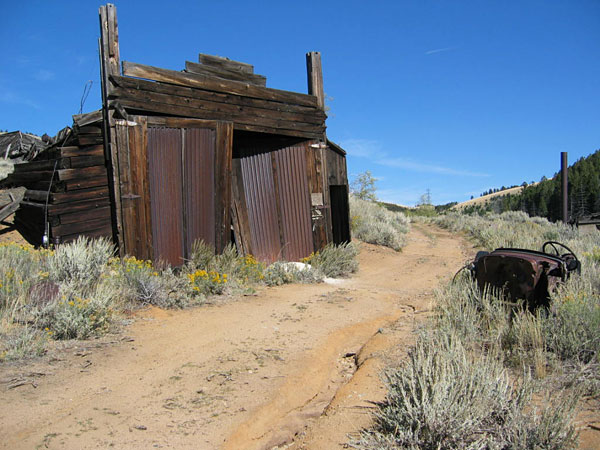 CREDIT: Photograph by Caitlin DeSilvey.
CREDIT: Photograph by Caitlin DeSilvey.Abandoned places—ghost towns and gutted factories, derelict dwellings and vacant lots—litter the American landscape. No longer needed, buildings slowly decay into battered husks. Molds and microbes break structures down into organic matter; animals and plants move in as people move out. Americans generally accept this kind of decay only in certain contexts: What is picturesque in a deserted mining camp can be deeply disturbing on a residential city street. And even in the ghost settlements of the West, the impulse to hold on to the material past is strong. But what happens when we let these places go? What lessons can we glean from their gradual disintegration? Decay erases certain histories. But it can release other stories about place and ecology that would otherwise go untold.
-
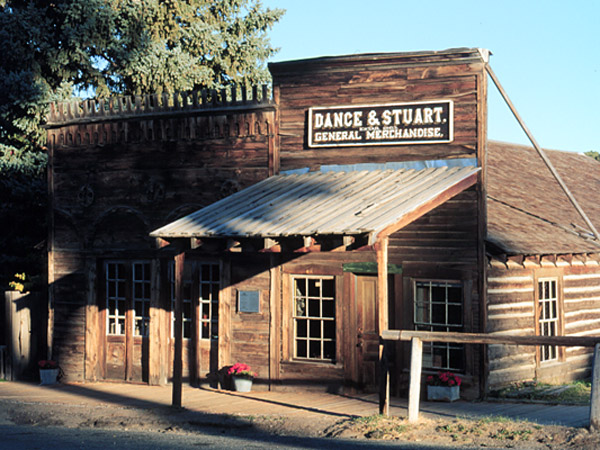 Image courtesy Travel Montana.
Image courtesy Travel Montana.Many of the forsaken boomtowns of the West are now the responsibility of federal and state agencies. The attitude of government managers to structural decay in ghost towns is often along the lines of "Thank you for your important contribution, now please go away." Ghost town workers take great pains to "arrest" decay at some indefinite point of maximum ghostliness; never mind that these places owe their wracked and weathered charm to rot and ruination. Restoration—one step beyond arrested decay on the continuum of historic preservation—aligned the Montana mercantile seen here with a "period of significance" in the late 19th century. Geraniums are optional.
-
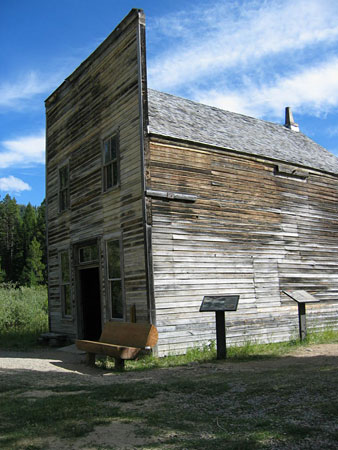 Photograph by Caitlin DeSilvey.
Photograph by Caitlin DeSilvey.Arrested decay exercises a lighter touch than restoration. Yet it still seeks to freeze the form of a building at a specific point in its history. This is a tricky process, since any effort to arrest or reverse time works against the natural inclination of matter to degrade and disappear. Preservation professionals spend a lot of time debating the virtues of different kinds of anti-fungal agents and the best way to keep damp out of vulnerable foundations and walls. As a result, we live among thousands of historic structures that would otherwise have disintegrated. Although this is undoubtedly good work, it always involves a measure of compromise. This Montana ghost-town saloon seems caught in limbo—not of the present, but not quite of the past it claims to stand for, either.
-
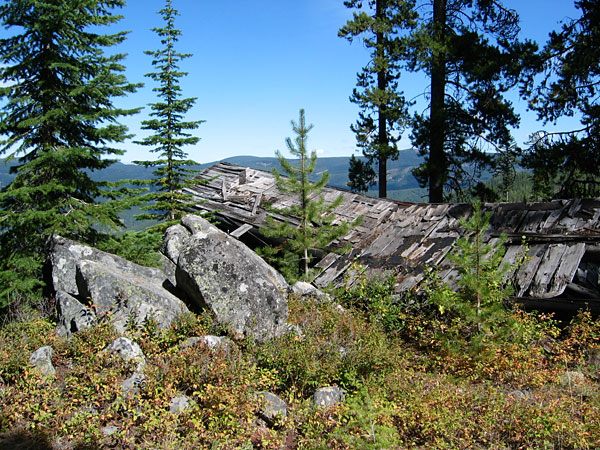 Photograph by Caitlin DeSilvey.
Photograph by Caitlin DeSilvey.When structures are left to their own devices, they melt instead of remaining frozen. At a former gold-mining camp a few miles down the road from the perky saloon in the last slide, a swaybacked miner's cabin lowers itself gently to the ground. The message here is quite different from the one on offer at the managed ghost town. For one thing, it's less easy to shrug off this place as a quaint but obsolete remnant of American history. In their unrestored state, the buildings recall the foolhardy capital that built the mine and the ultimate failure of the venture. The transience of human ambition is etched out in lichen on the iron of the former shaft works and in the moss that covers the rotten roofs. The cabin takes on the angle of repose of the rocks it lies among, the same rocks that brought hopeful miners into these hills to dig for gold and that eventually spit those people out as the human tailings of the 19th-century mining boom.
-
 Photograph by Tim Edensor.
Photograph by Tim Edensor.In this industrial ruin, a former Scottish quarry works, plants colonize the ledges of derelict structures, vines creep up railings, and animals occupy former cellars and broom closets. Ruined places are often rich ecological zones. When Charles Dickens visited the ruins of the Roman Colosseum in 1846, he was captivated by the "walls and arches overgrown with green … the long grass growing in its porches; young trees of yesterday, springing up on its ragged parapets, and bearing fruit; chance products of the seeds dropped there by birds." And not just by birds. A few years later, a visiting botanist cataloged 420 plant species in the ruin, many of them exotics from Asia and Africa that could only have come from seeds catching a lift on animals imported for the gladiatorial games. By 1880, archaeologists had scoured away this "recombinant ecology" and its fantastically rich history to leave behind the bleached edifice we know today.
-
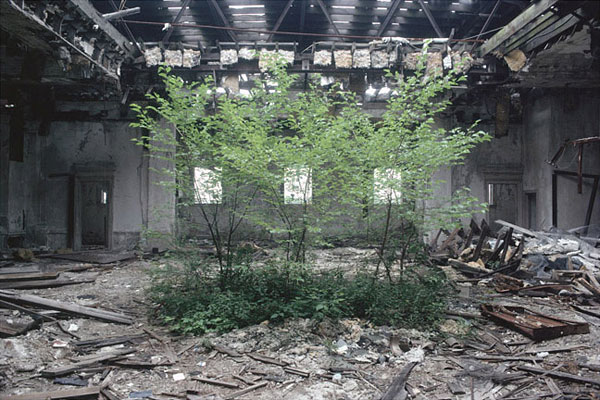 Photograph by Camilo José Vergara. Courtesy of CREDIT: invinciblecities.com
Photograph by Camilo José Vergara. Courtesy of CREDIT: invinciblecities.comLetting man-made structures decay to the point of disappearance is not an idea with a lot of popular or professional support, at least in America. In the mid-1990s, however, sociologist and photographer Camilo José Vergara proposed a "ruins park" for the mostly empty urban core of Detroit. In his "American Acropolis," the vacant buildings would become habitat for peregrine falcons and intrepid plants. The prairie would reseed the city streets. People would gather to witness a "memorial to a disappearing urban civilization." Detroit citizens did not welcome the proposal. It mattered little to them that Vergara found redemption and beauty, as well as regret, in their husk of a city.
In this slide, Vergara's photo of the derelict reading room of the Camden Free Library in New Jersey, a thicket of saplings reaches toward a tattered ceiling's filtered light. Historian Elizabeth Blackmar detects in Vergara's photos an "aesthetic pause," which leads us to wonder how we could have avoided the wasting away of these 20th-century landmarks—and to reflect on what we are to learn from their demise.
-
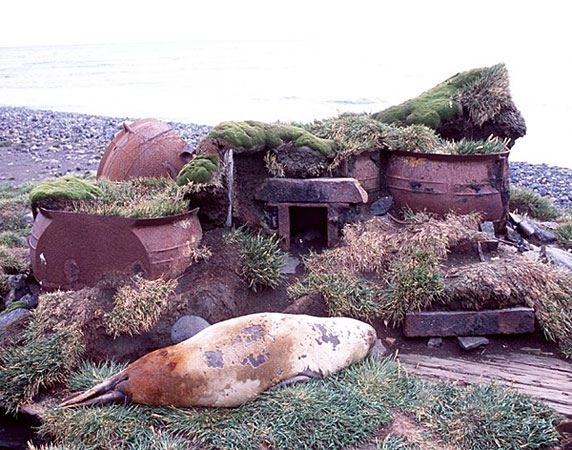 Photograph by E. Woehler, Australian Antarctic Division
Photograph by E. Woehler, Australian Antarctic DivisionAt a few historic sites, the professionals in charge accept decay as a legitimate natural process—and step out of the picture. The Australian Antarctic Division recently adopted a policy of "managed decay" for the cultural heritage of isolated Heard Island. As shown here, elephant seals bask among the mossy, rusting remnants of the rendering pots that would have melted them down to oil 150 years ago. On the Apostle Islands, off the Wisconsin shore of Lake Superior, the U.S. government's decision to designate a wilderness area raised troubled questions about the fate of remnant farms and fishing villages, lighthouses and tourist cabins. Strict application of wilderness principles would have erased the human history of the site—an inversion of the dilemma posed by historic preservation, which often seeks to erase wild histories. With some convincing, the National Park Service adopted a policy of "rewilding." Park service managers accepted the islands as a place where, as historian William Cronon puts it, "natural and human histories are intimately intermingled."
-
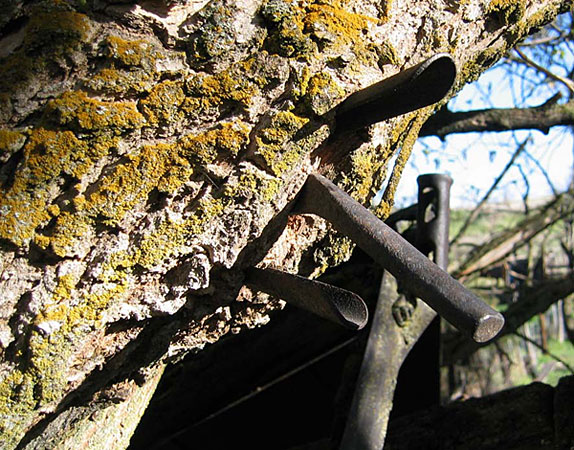 Photograph by Caitlin DeSilvey.
Photograph by Caitlin DeSilvey.At the semiderelict homestead in Montana where I live and work, the handle of a discarded grain-binding machine pokes out of the bark of a box elder tree. The tree clocks technological advance and agricultural decline in a 50-year accumulation of cellulose and lichen. The obsolete machine speaks to the history of human labor on this hardscrabble farm. And it also illustrates a dynamic process of landscape change—which can be seen as evolution or devolution depending on your perspective. Here human beings have ceded to the tree some control over storytelling about the past. Even if we're not ready for the managed decay of our rust-belt cities, such an approach might take root in more overlooked places like this one.
-
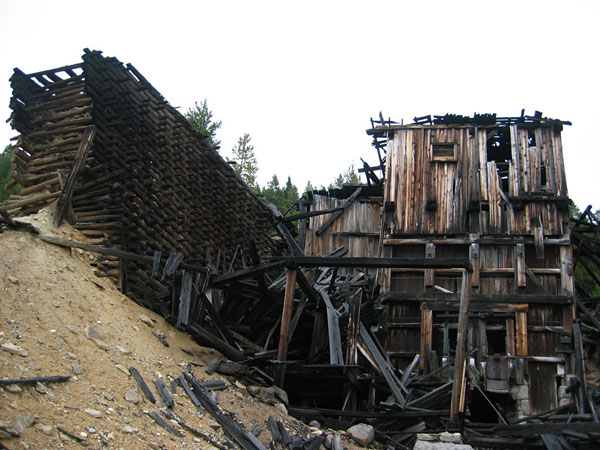 Photograph by Caitlin DeSilvey.
Photograph by Caitlin DeSilvey.As managers of established historic sites struggle to scrape together the funds for basic maintenance, let alone restoration, only a handful of former homesteads and farmhouses can be preserved to stand in for the thousands that quietly turn to dust. Where decay is unavoidable, the current practice of benign neglect might be replaced with a more attentive—but relatively inexpensive—practice of observation and interpretation. Time-lapse photography could document the incremental collapse of structures over decades, until only shadows in the forest duff remain. Interpretation could focus on the ecology of the reclaimed sites, drawing out the way former land uses—mining, farming, irrigation—led to colonization by particular plant and animal species. People could watch as places cross the threshold from history to archaeology, and then beyond.
-
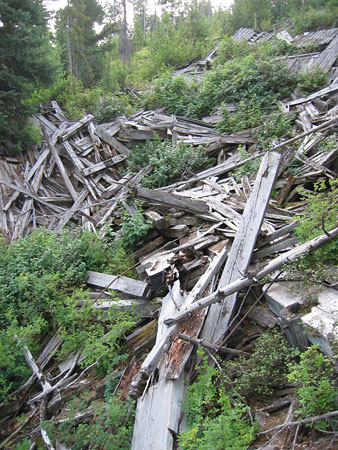 Photograph by Caitlin DeSilvey.
Photograph by Caitlin DeSilvey.Managed decay may sound appealing in the abstract, but it remains to be seen how comfortable we can become with it. Can we look on as a massive mill becomes a scree of gray timbers on a green hill, or will we prefer to avert our eyes until the ugly part is over? The devolution of a historic site exposes human constructions as no more than temporary arrangements of energy and matter. The decaying mill timbers release their energy to feed the saplings of a new forest—a forest that, in turn, will feed the engines of some other equally transitory human use. Three decades ago, Kevin Lynch, musing on similar themes, asked, "Can we accept that we are part of a universal wasting stream, and see in that our place and our connection?" Maybe, and maybe not. We are surrounded by our entropic heritage. The question is whether to appreciate and learn from it as it goes, on and on and on.
Click here